Tag Archive for: DLBCL treatment
How Can Patients Access the Latest DLBCL Treatment Options?
How Can Patients Access the Latest DLBCL Treatment Options? from Patient Empowerment Network on Vimeo.
How can diffuse large B-cell lymphoma (DLBCL) patients learn more about developing research and new treatments? Dr. Justin Kline provides key advice to access the latest treatment options.
Dr. Justin Kline is the Director of the Lymphoma Program at the University of Chicago Medicine. Learn more about Dr. Kline, here.
See More From The Pro-Active DLBCL Patient Toolkit
Related Programs:

|

|
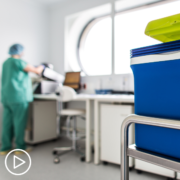
|
Transcript:
Katherine:
With all of these treatments in development, how can patients ensure that they’re receiving the latest treatment options?
Dr. Kline:
Yeah. It’s complicated, even for somebody who’s in the business. There are so many clinical trials going on all over the place and at various stages. I think, as I mentioned early on in our conversation, one of the best ways to make sure that you or your loved one is receiving the most advanced care is to get that second opinion, particularly at a center that does clinical trials. And it doesn’t have to be an academic center. There are many offices in the community that also run clinical trials, but I think meeting with somebody who treats DLBCL for a living at least once to talk about those options is a good idea.
The second approach is really to get engaged. And it may not be the person with lymphoma, sometimes it’s a spouse or a child, usually a grown child, but doing due diligence, getting involved with websites, Lymphoma Research Foundation, Leukemia-Lymphoma Society, where you know you’re getting good information. Folks like you guys who are involved in patient education. I think I have seen many patients who come in extraordinarily well educated about DLBCL, even before their first visit, and I do think it does make a difference in helping them decide what and where they want to get their treatment.
Katherine:
Yeah. What resources would you recommend for patients to help them stay up to date or to learn more about their disease?
Dr. Kline:
Sure, yeah. Again, I think as folks sort of meet with their oncologist or oncology nurse, each office or center may have their own specific recommendations. I really like, as I mentioned, the Lymphoma Research Foundation, which I think is LRF.org*, the Leukemia & Lymphoma Society, LLS.org. They not only have a website that has a lot of information on it, but they often have patient education days once or twice a year where specific lymphomas are discussed in their treatment, that’s geared toward people with lymphoma and their caregivers.
They also have, it talks about dealing with chemotherapy, the financial toxicity associated with cancer treatments, how to sort of share your diagnosis with your children and other family members, so it’s not just doctors that are barking at you all day long, but it’s other people, social workers, lawyers, nutritionists, nurses. So, those are probably my two favorite organizations, but there are many others where people can get very good and useful information about DLBCL and other lymphomas as well.
Which Emerging DLBCL Therapies Are Showing Promise?
Which Emerging DLBCL Therapies Are Showing Promise? from Patient Empowerment Network on Vimeo.
What’s next in diffuse large B-cell lymphoma (DLBCL) treatment? Dr. Justin Kline reviews developing research that could transform the future of DLBCL treatment.
Dr. Justin Kline is the Director of the Lymphoma Program at the University of Chicago Medicine. Learn more about Dr. Kline, here.
See More From The Pro-Active DLBCL Patient Toolkit
Related Programs:

|

|

|
Transcript:
Katherine:
What about emerging therapies, Dr. Kline? What approaches are showing promise?
Dr. Kline:
Well, I think probably in DLBCL, the biggest breakthrough, I don’t even know that I can call it emerging at this point, because it’s on the market, so to speak.
But I think it’s important to talk about, again, is CAR T-cell therapy, and this is a type of immune therapy where a person’s own immune cells called T-cells are taken from his or her bloodstream. And then using a special type of a virus, those T-cells are manipulated or engineered, that sounds better, to express on their surface something called a chimeric antigen receptor, which is somewhere between an antibody and a normal T-cell receptor. But anyhow, this chimeric antigen receptor confers or allows the T-cell to recognize a protein that’s expressed on the surface of B-cells, cancerous or otherwise, called CD19. And when that chimeric antigen or CAR antigen, excuse me, that CAR receptor expressing T-cell sees a lymphoma cell, it engages it and kills it, a pretty clever idea which has been in the works for decades now.
But CAR T-cell therapy has now been approved for not only DLBCL but many other types of non-Hodgkin lymphoma. And I think in the past decade, far and away, that’s the biggest breakthrough. There are other types of immunotherapy, probably most notably a type called bispecific immunotherapy, which is a pretty clever type of immune therapy where these specially engineered antibodies that are capable of binding or sticking to not only a person’s T-cell, a T-cell that’s already in his or her body, and a B-cell, a lymphoma cell that’s right next to that T-cell, sort of holds them together, and the part that binds the T-cell actually activates it, triggers it to kill the B-cell. And so there are a number of companies that have those bispecific therapies that are in development. I suspect a couple will be approved by the FDA, I would guess, in 2022.
These bispecific immunotherapies have been very effective, again, in DLBCL that’s come back, relapsed or refractory, as well as in other lymphomas. They do have some side effects that are similar to what we see in folks with CAR T-cell therapy. I won’t belabor what those are, but they are also very effective. There’ve been a number of drugs that, either immunotherapies or other types of therapies, that target that same CD19 protein on diffuse large B-cell lymphoma cells that have recently been approved by the FDA, either alone or in combination. Targeted therapies are always exciting. Although as compared with other lymphomas, these targeted therapies, many of which are oral, which are pills, have not been particularly effective in relapsed DLBCL.
So, I think that among the most exciting therapies are those that take advantage of our own immune systems to recognize and kill the lymphoma cells.
How Is Relapsed/Refractory DLBCL Treated?
How Is Relapsed/Refractory DLBCL Treated? from Patient Empowerment Network on Vimeo.
What options are available if a diffuse large B-cell lymphoma (DLBCL) patient doesn’t respond to treatment or relapses? Dr. Justin Kline discusses potential next steps in treatment for DLBCL patients with relapsed or refractory disease.
Dr. Justin Kline is the Director of the Lymphoma Program at the University of Chicago Medicine. Learn more about Dr. Kline, here.
See More From The Pro-Active DLBCL Patient Toolkit
Related Programs:

|

|
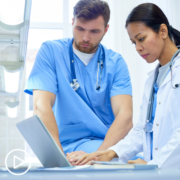
|
Transcript:
Katherine:
Let’s talk about if someone doesn’t respond to initial treatment or they relapse. Let’s start by defining some terms for the audience. What does it mean to be refractory?
Dr. Kline:
So, refractory is a term that’s used to describe a situation where a person has received treatment but that treatment hasn’t worked as well as we have expected. And the most – probably the most important scenario is after initial treatment.
Most people, for example, who receive R-CHOP, somewhere between 80 and 85 percent will have a completely negative PET scan after treatment. That’s remission. If the PET scan is not negative and you do a biopsy and it shows that there’s still lymphoma there, that’s what’s called primary refractory. In other words, the person’s lymphoma was refractory to initial or primary treatment. And in clinical trials that are testing agents, drugs or immunotherapies in folks who’ve had multiple treatments, usually refractory is used to define someone who has either not responded or has had a very, very short response to whatever the last treatment they had was.
Katherine:
How does relapse then differ from refractory?
Dr. Kline:
So, right, so relapse suggests that the lymphoma at some point was in a remission, right?
And so for example, a person gets six treatments of R-CHOP, has a PET scan at the end, the PET scan is clean. We say you’re in remission. Eight months later, the person develops a newly enlarged lymph node, and a biopsy shows that the lymphoma has come back, right? That’s what we would call a relapse. There was a period of remission, whereas refractory usually means there was never a period of remission to begin with.
Katherine:
Got it. How typical is it for a patient to relapse?
Dr. Kline:
Well, again, if you look at all comers, if you treated 100 people with DLBCL, most, probably 70 to 75 percent, would go into remission. About 10 or 15 percent would have primary refractory disease and another 10 or 15 percent would have a remission that would end at some point and they would have a relapse. So, it’s not terribly common.
The problem is that once the lymphoma has either demonstrated that it’s refractory to treatment or it’s come back, it’s relapsed, it’s a little bit more difficult to cure the lymphoma at that point.
Katherine:
How are patients treated then if they’ve relapsed or refractory?
Dr. Kline:
Well, so for somebody who’s had primary refractory lymphoma or has a lymphoma that’s relapsed after initial therapy, again, say for the sake of argument with R-CHOP, for many, many years, the next line of treatment if you will was to administer what we call salvage chemotherapy, and this is different chemotherapy from the original R-CHOP, that’s meant to put the lymphoma back into remission. In other worse, to salvage a remission. And for folks whose lymphomas were sensitive or responded, shrunk down to that salvage chemotherapy, we would consolidate that remission.
We would make it deeper using high dose chemotherapy and an autologous or a cell, stem cell transplant. And that’s been the standard of care for younger patients for decades.
That paradigm has been challenged, particularly in refractory patients or those who have very early relapses after R-CHOP, by two important clinical trials that have demonstrated superiority of a type of immunotherapy, a cellular immunotherapy called CAR T-cell therapy, which seems to be more effective even than stem cell transplantation in that population of folks.
How Is DLBCL Treatment Effectiveness Monitored?
How Is DLBCL Treatment Effectiveness Monitored? from Patient Empowerment Network on Vimeo.
How will patients know if their diffuse large B-cell lymphoma (DLBCL) treatment is working? Dr. Justin Kline defines DLBCL treatment goals and explains how they are monitored throughout the treatment process.
Dr. Justin Kline is the Director of the Lymphoma Program at the University of Chicago Medicine. Learn more about Dr. Kline, here.
See More From The Pro-Active DLBCL Patient Toolkit
Related Programs:

|

|

|
Transcript:
Katherine:
Let’s turn to what happens after treatment. How is the effectiveness of the treatment monitored?
Dr. Kline:
Well, so depends on the doc to some degree, but I like to do some, what I call interim imaging. So, we’ll typically, again, depending on the stage, but very often we’re delivering six treatments of R-CHOP, usually given every three weeks. So, the total treatment course is about four and a half months. It can be a little bit shorter for patients who have Stage 1 or Stage 2 DLBCLs. I like to get interim imaging, which is either a PET scan or a CAT scan, done sort of in the middle of treatment, just to give us a sense of how things are going. Are the lymphomatous tumors shrinking down? Some patients are, even by the middle of treatment, are in a complete remission. Their PET scan has gone totally normal. And then at the end of treatment, that’s probably the most important imaging, and there I do like to do PET scans again. Again, they’re the most sensitive test we have to detect lymphoma.
And so at the end of treatment, usually about four to six weeks after somebody completes treatment, we like to get that end of treatment PET scan, and that’s the PET scan that allows us to say, you’ve had a complete response. You’re in a complete remission, or not.
Katherine:
So, what does remission mean exactly then?
Dr. Kline:
So, in DLBCL, remission is pretty simply defined as absence of disease on, or absence of cancer on the tests that we do to detect it. Again, typically PET scans, and if somebody had involvement of his or her bone marrow at the beginning before treatment, we’ll repeat that bone marrow at the end of treatment just to make sure that there’s no lymphoma left over. And so, but for most people it’s a PET scan. If the PET scan does not show any abnormalities, then that’s what we call a complete remission or remission.
Katherine:
Is a cure possible for patients with DLBCL?
Dr. Kline:
Cure is not only possible, it’s actually quite common. If you look at all comers, regardless of stage, age, what have you, approximately 60 to 65 percent of folks who are treated for DLBCL are cured. The cure rates are higher with folks with earlier stage lymphomas, but even folks who have advanced DLBCL are frequently cured.
Which Factors Impact DLBCL Treatment Decisions?
Which Factors Impact DLBCL Treatment Decisions? from Patient Empowerment Network on Vimeo.
When making a decision about diffuse large B-cell lymphoma (DLBCL) treatment, what should you consider? Dr. Justin Kline reviews key patient factors that impact therapy decisions, including comorbidities and treatment side effects.
Dr. Justin Kline is the Director of the Lymphoma Program at the University of Chicago Medicine. Learn more about Dr. Kline, here.
See More From The Pro-Active DLBCL Patient Toolkit
Related Programs:

|

|

|
Transcript:
Katherine:
Other than a newly diagnosed patient’s stage of DLBCL and their age, what other factors would impact a treatment decision?
Dr. Kline:
Yeah. So, that’s a good question, so you named I think the biggest two, the most important two. Although I have to say that even people in their – oftentimes in their 80s are prescribed full dose therapy. The goal of our treatment, especially in newly diagnosed patients, is to cure the lymphoma, and so we tend to be aggressive. But outside of age, other things we consider are other health problems. Does the person have a healthy heart, healthy kidneys? How many other medical problems does the person have? How fit is the person? How sick is the person or symptomatic is the person from his or her lymphoma? And sometimes we take into consideration all those factors and we say, well, it’s still worth it to try to deliver the most intensive therapy that we can.
Other times we say, you know what? I think the risk of doing such is probably not worth the potential benefit, and so sometimes we’ll recommend dose reductions, reduce the doses of some of the medicines and the R-CHOP cocktail if that’s what we’re going to do, and occasionally, if the person has too many other things going on, we may talk about more palliative treatments, in other words, gentler treatments that may extend a person’s survival while hopefully maintaining a really good quality of life.
Katherine:
Yeah. What kind of side effects should patients expect?
Dr. Kline:
Well, that’s a conversation I’ve had many, many, many times over the years. And specifically to the R-CHOP cocktail, just because that’s the one that’s used most commonly, I tell people that the most common things are symptoms like fatigue, occasionally nausea, sometimes vomiting, although the medications we have to prevent those things are very good these days.
Constipation is not uncommon, hair loss, mouth sores. I think probably the most important thing is to recognize that the chemotherapy will suppress or reduce the immune system, and so we’re always worried about people catching infections when they’re on chemotherapy, because sometimes they can be serious. And then I talk about rare symptoms that are a big deal. Sometimes the chemotherapy can damage organs like the heart. It’s uncommon, but it happens sometimes. And chemotherapy, while we need to give it to cure the lymphoma, can sometimes cause secondary blood cancers like leukemias years down the road. The risk is low, but again, these are I think serious things that people, even if they’re rare, people need to know about them before they start.
How Is DLBCL Treated?
How Is Diffuse Large B-Cell Lymphoma (DLBCL) Treated? from Patient Empowerment Network on Vimeo.
Dr. Justin Kline explains what patients need to know about current DLBCL treatment, including R-CHOP, stem cell therapy, and clinical trials.
Dr. Justin Kline is the Director of the Lymphoma Program at the University of Chicago Medicine. Learn more about Dr. Kline, here.
See More From The Pro-Active DLBCL Patient Toolkit
Related Programs:

|

|

|
Transcript:
Katherine:
From what I understand, treatment really should start right away. So, what types of treatment are currently available to someone newly diagnosed with DLBCL?
Dr. Kline:
Sure, so for about 20 plus years now, the standard of care for most patients with DLBCL, regardless of whether it’s a germinal center or an activated B-cell type DLBCL, is a combination of what we call chemo immunotherapy, the acronym for which is R-CHOP, and each of those letters stands for a different medication. The R stands for rituximab, which is an antibody that coats the surface of lymphomatous B cells and sort of signals the immune system to come and kill those cells.
The C is cyclophosphamide, the H is hydroxy doxorubicin, and the O is Oncovin. These are each classical chemotherapy drugs, and they each work through a different mechanism to help kill lymphoma sells. And the P is a steroid pill called prednisone, so it’s a little bit complicated, but the reason that we use cocktails of medicines to treat lymphomas is that it really works to prevent the lymphoma cells from gaining the upper hand, from developing resistance to a single type of treatment.
Katherine:
Right.
Dr. Kline:
Now, I should say that for certain DLBCLs, particularly those double hit lymphomas that we talked about, sometimes we use a more intensive cocktail called dose-adjusted R-EPOCH. It has largely the same medications with an additional chemotherapy called etoposide.
The difference is that R-CHOP is given – all the drugs are given intravenously, with the exception of prednisone, over a single day. The dose-adjusted R-EPOCH is given over an infusion over the course of about five days. The other point I might make is that there was a recent large clinical study that compared R-CHOP to a new regimen called polatuzumab R-CHP. So, basically the O in R-CHOP was removed and substituted for this new drug called polatuzumab vedotin, and although many, many combinations similar to R-CHOP have been compared to R-CHOP over the past 20 years and failed, this regimen, polatuzumab R-CHP in the study called the POLARIX study actually was shown to improve what we call progression-free survival by about six percent. So, it may become a new standard of care for treating DLBCL, which is exciting, because we haven’t had one in over 20 years.
Katherine:
Right. That’s good news.
Dr. Kline:
Long answer to a short question, sorry about that. Yes, it is good news.
Katherine:
That is good news. What about stem cell transplants?
Dr. Kline:
Good question. So, for newly diagnosed patients, in this era, we rarely if ever are recommending stem cell transplant or stem cell transplantation as part of initial therapy. There are rare circumstances, but for the vast majority of patients who are, people who are diagnosed with DLBCL, it’s not recommended.
Katherine:
Where do clinical trials fit in?
Dr. Kline:
It’s a really good question. I practice at an academic medical center, and so one of our missions is to advance therapy and make it better. There’s no way to do that without performing clinical trials, so I think for – clinical trials aren’t for everyone. As a matter of fact, most people with lymphoma are not treated in the context of clinical trials.
But certainly I think they are important to consider, and number one, it’s possible that the particular person might be involved with the clinical trial that is very successful and actually improves their outcome. I always tell people that I see that being involved with the clinical trial is also, to some extent, an altruistic endeavor. You’re helping your doctors learn more about how to treat a type of cancer, hopefully better, maybe not, you know? So, there is some altruism that goes into clinical trials as well. So, I do think that most people who are able should consider having a second opinion. Doesn’t have to be at an academic medical center, but at least with another doctor, where clinical trial options can be discussed.
Tips for Making Treatment Decisions WITH Your DLBCL Team
Tips for Making Treatment Decisions WITH Your DLBCL Team from Patient Empowerment Network on Vimeo.
DLBCL expert, Dr. Jason Westin, explains shared decision-making and provides tips for engaging in your treatment decisions.
Dr. Jason Westin is the Director of Lymphoma Clinical Research in the Department of Lymphoma/Myeloma in the Division of Cancer Medicine at The University of Texas MD Anderson Cancer Center. Learn more about Dr. Westin, here.
See More From The Pro-Active DLBCL Patient Toolkit
Related Programs:

|

|

|
Transcript:
Katherine:
Lately, we’ve been hearing this term shared decision-making, which basically means the patients and clinicians collaborate to make healthcare decisions. And it can help patients take a more active role in their care. So, I’d like to get your thoughts on how best to make this process work. Are there questions that patients should consider asking about their proposed treatment plan?
Dr. Westin:
Definitely. And I think shared decision-making is something that we view to be critical. We want everybody on board to feel like they’ve got some sense of ownership of these decisions and that they’re involved in a way that’s meaningful. At the end of the day, the patients make the decisions about which treatments are right for them but they’re trusting their healthcare team to give them good advice. This is not something that patients have expertise in. This is often out of nowhere that somebody is newly diagnosed and this is not on their radar, not something that they ever thought that they’d be sitting in the chair talking about which type of therapy for this cancer.
And so, patients are often relying on the healthcare team to give them good advice. But it’s a fair question and it’s, I think, one that’s appropriate to ask. “Are there other treatment options that we should be talking about?” Basically, exploring, “Is this option you’re presenting the option or is this what you consider to be the best option.” Oftentimes physicians, and PAs, and nurse practitioners might filter information such that, “Yeah, there are other options but here’s why they’re bad. Here’s why they’re not right for you.”
But feeling that you have some clarity about why a treatment choice was made, I think, is often quite important. For first line DLBCL, there are less options to consider. But in the relapse space, there are lots of options. And those should be discussed. And sometimes the healthcare provider, a physician, might have their favorite that they have had good experience with treatment A and therefore they recommend treatment A to the next patient. But that may not always be the right treatment for a given patient.
There may be reasons to consider other treatments. And so, asking that question, “What else is out there? What other treatments are there? Anything else that we should be considering,” I think is a fair question to ask and an important one. And if the answer is, “No, there aren’t other treatment options. This is the one that we should choose,” at least you’re aware of that by asking that question. So, I think that’s an important one to clarify.
What Helps Determine a Patient’s DLBCL Treatment Path?
What Helps Determine a Patient’s DLBCL Treatment Path? from Patient Empowerment Network on Vimeo.
Since no two patients are exactly alike, how is DLBCL treatment determined? Dr. Jason Westin explains what factors he considers when determining a patient’s treatment path.
Dr. Jason Westin is the Director of Lymphoma Clinical Research in the Department of Lymphoma/Myeloma in the Division of Cancer Medicine at The University of Texas MD Anderson Cancer Center. Learn more about Dr. Westin, here.
See More From The Pro-Active DLBCL Patient Toolkit
Related Programs:

|

|

|
Transcript:
Katherine:
Since no two patients are exactly the same, I imagine then that their treatment approaches are different. So, what do you consider when determining the best treatment option for an individual patient?
Dr. Westin:
That’s a very important question. How can we personalize treatments in a way that gets us down to what a single patient needs, not both populations of thousands of patients, but the person sitting across the exam room.
Katherine:
Right.
Dr. Westin:
For first line DLBCL, someone who’s newly diagnosed, unfortunately the one size fits all of R-CHOP being the standard, or versions of R-CHOP, the new treatment that I mentioned having a slight improvement not yet approved by the FDA, there’s not as much customization or personalization outside of clinical trials as I would like. We’d love to be smarter and to be able to say, “Well, you have the subtype A of large B-cell, therefore you should get subtype therapy A,” or subtype B and you get subtype therapy B. We have more of a one-size-fits-all approach in our frontline treatment outside of clinical trials.
On clinical trials, sometimes patients will have a subtype of large B-cell. We talk about things called the cell of origin. We talk about things called double hit. There are specific subtypes of DLBCL that occasionally a clinical trial will target that subtype and have a therapy that’s supposed to work better in that subtype.
So, that’s another reason to consider clinical trials, is the ability to potentially to customize or personalize your therapy to go more specifically after what’s wrong with your cancer cells as opposed to having something that’s given as a shotgun approach to everyone. And the reason that R-CHOP is around for this long is that it works fairly well across the board in different subtypes. It’s not something that’s completely effective in one and completely ineffective in another.
But, in terms of personalizing therapies, clinical trials are an important thing to be considered. In the relapse space, with patients that have relapsed disease, there we have more potential to customize treatments and often that’s done based upon characteristics of the tumor or the patient’s preferences in terms of frequency of treatments, in terms of potential for side effects. There’s more that can be done if somebody’s already had a treatment and it came back. But clinical trials are a great way to try and customize, or to drill down in terms of specifics about your particular cancer.
Katherine:
Can you touch upon treatment side effects?
Dr. Westin:
Yes. Treatment side effects, obviously, are very important to our patients in terms of what does their quality of life look like while the therapy’s ongoing to try to get rid of this dread cancer. The side effects really depend upon what treatment we’re talking about. And if we focus on frontline treatments, the initial treatments being R-CHOP based treatments, side effects are chemotherapy side effects. And that includes low blood counts, white blood cells, red blood cells, platelets, risk of infection along with the low white blood cells, and risk of fevers prompting a trip to the emergency department for an evaluation.
Thankfully, that’s rare. Maybe one out of four or one out of five patients would have an infection during treatments. But if it happens, it can be serious. Fatigue, nausea – which is usually very well controlled with medications, but nonetheless has to be something we watch out for. And for many patients, it’s important to note that hair loss can occur from the chemotherapy. And that’s something that it’s easy to say, “Oh, I don’t care about that.” But for many people, when you look in the mirror and you see somebody else looking back at you, somebody that has a different physical appearance than you’re used to, it can be quite distressing.
That’s unfortunately part of many patients’ journey with the therapy for diffuse large B-cell lymphoma. In nonchemotherapy treatments – the targeted ones that I mentioned – these are the antibody drug conjugates, the targeted immune therapies, or in CAR T-cells, side effects can be very different, sometimes much less in terms of the side effects, other times completely different types of side effects. So, it really matters what type of treatment you’re talking about. And this is something you really want to clarify with your physician, with the nurse, with the PA.
“Tell me a lot of details about what I should expect when I’m feeling this. And give me reading materials so I can digest it, think about it, and figure out what questions I need to ask after we first discuss this.”
Katherine:
Yeah.
Dr. Westin:
The side effects really are an important part of the patient’s journey.
Emerging DLBCL Treatment Approaches
Emerging DLBCL Treatment Approaches from Patient Empowerment Network on Vimeo.
What is next for DLBCL treatment? Dr. Jason Westin describes emerging DLBCL treatment approaches.
Dr. Jason Westin is the Director of Lymphoma Clinical Research in the Department of Lymphoma/Myeloma in the Division of Cancer Medicine at The University of Texas MD Anderson Cancer Center. Learn more about Dr. Westin, here.
See More From The Pro-Active DLBCL Patient Toolkit
Related Programs:

|

|

|
Transcript:
Katherine:
Yeah. You touched upon this earlier, Dr. Westin, but aren’t there emerging DLBCL approaches the patient should know about?
Dr. Westin:
Yes. Thankfully, there are many, many. We could spend several hours talking about lots of new therapies coming along. So, it’s a great answer to have. It’s an embarrassment of riches that we have for lots and lots of new therapies that appear quite promising in the early development stage.
In terms of those that have actually crossed over the finished line to be approved by the FDA, we have a handful of new therapies in the past few years that have been approved. Previously, we didn’t really have very many, but now there are multiple therapies that are approved by the FDA outside of a clinical trial, that are targeted treatments.
And those include antibody drug conjugates, basically an antibody like you make against an infection. However, this antibody has a chemotherapy warhead attached to the back of it. So, effectively, it’s a heatseeking missile that finds whatever target we want it to find – in this case, cancer cells – and delivers a high dose chemotherapy right to the bad guys, not to the good guys. There are also other immune therapies that we’ve seen than can be very powerful antibodies, plus immunomodulatory drugs. And we can talk about specific names of these if we’d like.
And then, lastly, there are other oral agents that are coming along that look very promising in terms of their ability to target the cancer cells more directly than growing cells.
Lastly, there’s a very new class of therapies not yet approved, but very promising. I mentioned this before. It’s something called a bispecific antibody. Bispecific – the word bicycle meaning two wheels. Bispecific is two specific antibodies. Basically, it’s an antibody that’s grabbing onto a cancer cell and grabbing onto an immune cell. “I’d like to introduce you guys. Why don’t you guys come in proximity and see if we can have a party.”
And it’s an idea here of trying to get the cancer cell to be attacked by the immune cell simply through this close proximity that occurs. Not yet approved. Looks very promising and I think probably will be approved for multiple different lymphoma types, including large B-cell, in the coming years.
An Overview of Current DLBCL Treatment Approaches
An Overview of Current DLBCL Treatment Approaches from Patient Empowerment Network on Vimeo.
What do diffuse large B-cell lymphoma (DLBCL) patients need to know about current treatment approaches? Expert Dr. Loretta Nastoupil provides an overview and gives an update about ongoing research comparing two treatment regimens.
Dr. Loretta Nastoupil is Director of the Lymphoma Outcomes Database in the Department of Lymphoma/Myeloma at The University of Texas MD Anderson Cancer Center. Learn more about Dr. Nastoupil, here.
See More From The Pro-Active DLBCL Patient Toolkit
Related Programs:

|

Diffuse Large B-Cell Lymphoma (DLBCL) Treatment and Research News |

How Is Diffuse Large B-Cell Lymphoma (DLBCL) Treated? |
Transcript:
Katherine:
Dr. Nastoupil, now that we’ve discussed factors that go into the treatment choices, can you walk us through the currently available DLBCL treatment approaches and who they might be right for?
Dr. Nastoupil:
Absolutely. So, again, this is changing, and that’s good news. So, up until recently, R-CHOP or rituximab in combination with CHOP, which is an acronym for four different drugs, cyclophosphamide, doxorubicin, vincristine, and prednisone, has been our standard.
Again, what would potentially challenge that is the POLARIX study where we exchange vincristine for polatuzumab. We don’t know the results of that study yet. All we know is that it met its primary endpoint, meaning it met what it set out to do in terms of improving upon some of the outcomes achieved with R-CHOP.
We need to see the details to know if that means now every newly diagnosed diffuse large B-cell lymphoma patient will be offered the polatuzumab in combination with R-CHP study or whether or not there will still be some patients appropriate for R-CHOP.
But that is generally our first approach. Whether you get six cycles or a shortened course plus/minus radiation depends on your state. Once patients have completed therapy, generally, then we pursue what’s called surveillance.
So, we’re monitoring for any signs that the lymphoma has recurred or has not gone away. That’s a controversial topic in terms of how to conduct surveillance and one that I suspect will change over time. But for most patients, if the lymphoma is going to recur, it generally recurs within the first two years.
So, assessing patients either in the form of a CT scan, a PET CT, or a physical exam with labs every four to six months for the first two years is what most practices will pursue. I’m not saying that there is no chance that you would relapse beyond two years. It’s just that the majority of patients, at least 90 percent, if the lymphoma comes back, it usually does so within two years.
And the relapses that occur beyond two years are less predictable. They could happen at three years. They could happen at 10 years, as it’s hard to know how to do surveillance beyond two years.
If the lymphoma recurs, the first thing we need to do is biopsy it because there are many things that can mimic lymphoma on a scan – infection, inflammation, other tumor types. So, if there is ever a question about whether or not the lymphoma has recurred, I generally advise for all patients they undergo a biopsy to ensure that we know what we’re treating.
Depending on when the lymphoma recurs, if it happens within 12 months, this is another area that we are shifting our practice. In the past, for all patients who had relapsed large cell lymphoma, we would pursue what we call salvage or second-line chemotherapy. So, we mix up the chemo. We keep, generally, the rituximab, but we alter the chemotherapy agents. We wouldn’t give CHOP again.
And then we give a shortened course where we give two to three cycles. We repeat the scan. And for patients who’ve achieved what we call chemo-sensitive disease – so, that’s generally a complete response on scan – we would then move forward with high-dose therapy and an autologous stem cell transplant. So, essentially giving different but more intense chemo and rescuing patients from that maneuver with their own stem cells that will go back to the bone marrow and start making white blood cells, red cells, and platelets again.
What has shifted in the last six months is we now know that CAR T-cell therapy is superior to that approach, at least with two CAR Ts for patients whose lymphoma came back within 12 months. Again, we’re eagerly awaiting the full results of those randomized studies. But three trials were conducted. Two of the three suggest CAR T is better than second chemo and transplant for those patients who relapse within 12 months.
So, currently, we think that you’ll have a CHOP-like therapy with plus rituximab frontline. If you progress within 12 months, you potentially would be a candidate for CAR T-cell therapy. If the CAR T-cell therapy fails, which is true for about half of patients. Or if you’re deemed to not be a candidate for CAR T, we have several other new options that didn’t exist a year ago, including targeted or non-chemotherapy options.
So, there are at least four options in that setting now that are therapies that target the lymphoma cells, either by targeting CD19, which is another surface marker, augmenting that either with an antibody drug conjugate, such as loncastuximab tesirine (Lonca), or with an immune therapy, such as lenalidomide (Revlimid) and tafasitamab. Polatuzumab (Polivy) is available in that third line or later space combined with bendamustine (Treanda) and rituximab (Rituxan). There’s an oral agent called Selinexor (Xpovio).
So, a lot of that is not to burden patients with information but to let them know they’ve got lots of options. And many of these can be sequenced. So, if we can’t achieve cure with R-CHOP and/or CAR T, there are still very good outcomes in that third line or later space.
The Benefits of Having a Role in Your DLBCL Treatment Decisions
The Benefits of Having a Role in Your DLBCL Treatment Decisions from Patient Empowerment Network on Vimeo.
Diffuse large B-cell lymphoma (DLBCL) patients have a vital role in their treatment decisions. Expert Dr. Loretta Nastoupil shares advice for patients on how to advocate for their best care, the value of a second opinion, and credible resources to boost knowledge about DLBCL.
Diffuse large B-cell lymphoma (DLBCL) patients have a vital role in their treatment decisions. Expert Dr. Loretta Nastoupil shares advice for patients on how to advocate for their best care, the value of a second opinion, and credible resources to boost knowledge about DLBCL.
See More From The Pro-Active DLBCL Patient Toolkit
Related Programs:
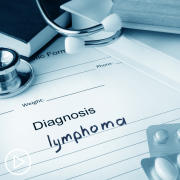
|

|

|
Transcript:
Katherine:
But what do you feel is the patient’s role in this whole decision?
Dr. Nastoupil:
So, I’ve actually been a patient myself, and I have mixed feelings about it. I think oftentimes as an oncologist, we share decision-making when we don’t know the exact path forward, meaning if there’s something controversial or you have more than one option, generally, we kind of put out all the information to the patient, and we want you to be part of that decision-making.
And I think that’s important because we’re all humans, and we all want liberties. And we want our patient rights to be acknowledged and respected. And that’s important. I think sometimes though that also burdens patients with making decisions when they may feel they don’t have all of the information to make an informed decision.
But your role as the patient is you know your body better than anyone. And, generally, if there’s something that just doesn’t fit well or sit well with you, be vocal about it. So, I’ve been in a situation where I felt like I had to speak up a few times, and not that I have all the answers. And I am an oncologist. So, I generally have more insight than others.
But, generally, I was right in that, again, I think we know our own bodies. And when you feel that something is being missed or maybe not given the time and attention it deserves, speak up. You also have a role in making sure that the diagnosis is correct.
So, I generally advise all patients because everything hinges on the diagnosis in lymphoma, more so than the staging, more so than sometimes even the treatment itself.
Getting a second opinion can be incredibly valuable because you have another pathologist that will lay eyes on this biopsy. And lymphoma is rare. So, a second opinion can be incredibly valuable, and that’s usually something driven by a patient more so than an oncologist. Though some oncologists – and I would say the majority – are open to an opinion because they too would like information or confirmation that they’re on the right path.
Katherine:
Certainly.
Dr. Nastoupil:
The other thing that I think patients can have role is exploring what trial options are out there and available to them. I think that is sometimes a tough subject to discuss. Clinical trials are not only for patients who have failed all the standard treatments.
And it’s usually not an option of hospice versus a clinical trial. That’s absolutely an inappropriate time to consider a clinical trial. And, generally, there are trials at any point in a patient’s journey where there is some controversy as to the best path forward.
Again, I’ve been discussing the last 40 years of trying to improve upon R-CHOP is because 60 percent of patients were cured, but 40 percent were not. There is always a scenario where we could do better. And, generally, the only way we will improve upon outcomes is to conduct important rational clinical trials.
So, sometimes, it’s as simple as reaching out, participating in programs such as this, reaching out to The Lymphoma & Leukemia Society or the Lymphoma Research Foundation to just explore what are your trial options. They may not be appropriate for you right now, but at least understanding where there is an opportunity to participate in a trial is worth exploring.
Katherine:
Dr. Nastoupil, I’m wondering how patients can feel confident in speaking up and becoming a partner in their care?
Dr. Nastoupil:
So, it’s important to recognize, and I reflect on this all the time. Generally, once patients have been rendered a diagnosis of cancer, that’s a life-altering event. And even if I spend a lot of time trying to reassure patients that outcomes for lymphoma patients are very good, generally we’re aiming for cure, that’s not true for everyone.
And you can’t help but be concerned that you will succumb to this disease or that the toxicity of therapy is going to be life-altering and impact your quality of life in such a way that it’s no longer the life that you were happy to live.
And so, I recognize that we are partners in this. My job is to choose the most effective therapy that will try and accomplish the goals we set out to achieve. However, sometimes, oncologists make assumptions about what the goal of a given patient is.
We’re assuming that longevity or living is the most important goal. Whereas sometimes, people might care more about the quality of life, or they may need more reassurances about what the options are or their realistic outcomes with therapy. Because, again, I’ve mentioned before, oncologists are generally eternal optimists. We tend to sugarcoat things a little bit.
So, it’s important for patients to recognize that they will have a shared decision responsibility, meaning oftentimes we will provide all the information that we have access to in terms of a given treatment.
What is the likelihood of success, what is the potential risk in terms of toxicity, and what we’re leaning towards one therapy over another, particularly if you have more than one option.
But, ultimately, we need patients to share with us what their goals are in terms of outcome of that treatment so that we can then potentially refine our treatment selection. So, again, being informed, participating in programs like this so that you understand what makes one lymphoma different from another. Why would one oncologist offer one treatment and another discuss something else?
So, understanding what the different lymphomas are, how they might be approached differently, what the new therapies are. I struggle to keep up with just the lymphoma literature and changes. I can’t imagine what it must be like for an oncologist that treats every cancer type. So, again, understanding that new drugs are approved almost every couple of months in lymphoma may provide an opportunity for patients to share new information with their oncologists as well.
What Are the Goals of DLBCL Treatment?
What Are the Goals of DLBCL Treatment? from Patient Empowerment Network on Vimeo.
A diffuse large B-cell lymphoma (DLBCL) treatment plan may have different goals depending on the patient. Expert Dr. Loretta Nastoupil provides an overview of factors that play into treatment decisions and shares information about current and emerging DLBCL treatments.
Dr. Loretta Nastoupil is Director of the Lymphoma Outcomes Database in the Department of Lymphoma/Myeloma at The University of Texas MD Anderson Cancer Center. Learn more about Dr. Nastoupil, here.
See More From The Pro-Active DLBCL Patient Toolkit
Related Programs:

|

|
Transcript:
Katherine:
Many factors come in to play when making a treatment decision, including a patient’s age and overall health. So, let’s walk through some of these considerations. Let’s start with treatment goals. What does this mean exactly? And what are the goals of treatment for DLBCL?
Dr. Nastoupil:
Great questions. For diffuse large B-cell lymphoma, my goal was that I want to eradicate this disease with one course of therapy. Now one course of therapy, again, may mean six cycles of treatment, or it may mean three to four plus/minus radiation. And that kind of gets back to the discussion we just had with stage. But the goal is to make it go away and never come back. Now, oncologists are eternal optimists.
And I saw this because we would not be oncologists if we weren’t always focused and hoping for the best outcomes for our patients.
Katherine:
Sure.
Dr. Nastoupil:
So, we, generally, when we’re counseling patients tend to keep the focus on what is the chance that I can cure this, and we use words like cure oftentimes. But there’s always those caveats. And those caveats are – we can’t really look into our crystal ball and predict the future for every given patient. So, we use tools to help us risk stratify patients, meaning if we took 100 people like a given person, we could predict the outcome for the majority of those patients.
So, with diffuse large B-cell lymphoma with no high-risk features – so, that gets back to the molecular subtype. Do they have double hit features – yes or no? The stage and something we call IPI, International Prognostic Index, that takes into account some clinical features. As you mentioned, patient specific factors, their age, their stage, some lab values, whether or not they have more than one extranodal variable. Then we can generally predict.
Again, if I have 100 patients with good risk IPI, 80 percent of them are likely to be cured and alive and well five to 10 years later. If I have someone with poor risk features that may not change exactly what I do for that patient, but that may help them and me in terms of should I be pursuing a trial to potentially have access to something that’s better than this standard option? Or how does this impact their planning?
Some people are close to retirement. Some people have specific life goals, such as a wedding or an anniversary that sometimes we use those sorts of calculators to best predict the future to inform some of that treatment. So, those are what we call sort of the characteristics coming into treatment.
There are comorbidities or sort of concomitant medical problems, such as heart disease, sometimes diabetes. But, generally, more often than not, it’s how healthy your heart is because my objective with treatment is to cure this.
Cure generally results from chemotherapy. And we can spend some time talking about why have we not moved away from chemotherapy in this disease? But, generally, that does involve chemo because that’s generally how I can eradicate this tumor.
But there are certain situations where that chemo may not be beneficial to a given a patient. It usually has to do with how healthy their heart function is at baseline. So, again, we look at all of these factors. What is their risk with the disease? What is their risk from the toxicity of treatment? And am I able to achieve that goal, which is to eradicate the disease?
Katherine:
Well, let’s talk about chemotherapy. Why is that still part of the regimen in a treatment plan?
Dr. Nastoupil:
Yes, I’m going to borrow an analogy that one of my colleagues Jason Westin uses all the time. The CHOP chemotherapy that is the backbone of our treatment for diffuse large B-cell lymphoma was developed in 1976.
There is no other technology that we would commonly use in our day to day. You wouldn’t still be driving your car you had in 1976. Clearly, our methods of communication in regards to phones have changed dramatically. So, why are we still using chemotherapy that was developed in 1976?
Katherine:
True.
Dr. Nastoupil:
Well, it’s not for lack of trying. Over the last four or five decades, we have been trying to improve upon this. And it works. It works for at least 60 percent of patients. When we tack on targeted therapy, such as immune
therapy where we use an antibody that will stick to the surface of a marker on that lymphoma cell and then use the immune system to do some of the heavy lifting, we can probably improve those cure rates from 60 percent to potentially as high as 80 percent. That’s really been the only substantial improvement we’ve made.
Now, there is one caveat. So, just recently, we heard a press release of the POLARIX study, which is the first trial in the last four decades that could potentially replace R-CHOP as the standard of care.
We don’t have the full results yet. It’s essentially utilizing a drug called polatuzumab, which is an antibody drug conjugate. It’s essentially chemo on a stick. But we’re delivering chemo specifically to (CD)79b, which is a target on B cell lymphomas and modifying the CHOPs. We’re not getting rid of chemo altogether. We’re dropping one of the chemotherapy agents and replacing it with this targeted agent. So, it’s essentially CHOP plus rituximab and polatuzumab might be the new standard.
But, again, that’s based off many, many efforts to try and replace CHOP. And we’re making slow incremental improvements, but we’re still keeping the therapies that tend to work.
How Is Diffuse Large B-Cell Lymphoma (DLBCL) Treated?
How Is Diffuse Large B-Cell Lymphoma (DLBCL) Treated? from Patient Empowerment Network on Vimeo.
How is diffuse large B-cell lymphoma (DLBCL) treated? Dr. Jean Koff shares insight about DLBCL treatment types, factors to consider in determining treatment options, reviews approaches for relapsed disease, and explains the role of clinical trials.
Dr. Jean Koff is an Assistant Professor in the Department of Hematology and Oncology at Winship Cancer Institute at Emory University. Learn more about Dr. Koff, here.
See More From The Pro-Active DLBCL Patient Toolkit
Related Programs:

|
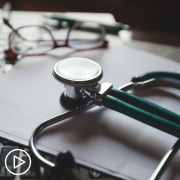
|
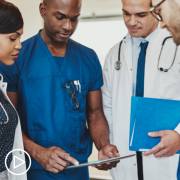
|
Transcript:
Katherine Banwell:
In general, then Dr. Koff, how is DLBCL treated?
Dr. Koff:
So, in general for patients who are getting their first-line therapy, they will receive some sort of combination of chemotherapy and what we call immunotherapy. For the vast majority of patients who are young and otherwise, healthy this will be a combination chemotherapy regimen known as R-CHOP.
Which consists of three what I call conventional chemotherapy drugs, an immunotherapy called cyclophosphamide and a steroid known as prednisone.
Katherine Banwell:
What are the main factors you take into consideration before a treatment approaches decided on? You mentioned age, health.
Dr. Koff:
Yes. So, I divide it into three different categories. The first category is the patient. So, there are patient factors that determine what treatments the patient is able to tolerate. And some of the main factors you mentioned are items like age or what we call co-morbidities, which are other health problems that the patient may have. But there may be other factors as well.
If a patient is not able to take care of themselves very well, because they’re very ill or they’re very debilitated or they’re unable to receive certain treatments because they have social factors that keep them from coming to certain centers or from following-up with care. Those all fall under that patient-centered bracket.
The next factor that I consider are items related to the lymphoma itself. So, we’ve already mentioned factors like, expression of different genes or having certain gene abnormalities. Those may play a role in determining what treatment a patient gets. And then, the last big category is where the lymphoma is in the body. And this refers, generally if the lymphoma is only in one limited site. Then those patients may get fewer cycles of chemotherapy, less time in chemotherapy and may receive radiation as part of their frontline treatment.
Whereas patients who have disease in more than one site who are spread out across the body, make it more cycles of chemotherapy. But also there are patients who have lymphoma in certain sites that requires that we give additional treatment to make sure that the disease in those special sites is treated
Katherine Banwell:
Where do clinical trials fit in, Dr. Koff?
Dr. Koff:
So, our goal in treating diffuse Large B-cell lymphoma in the first-line setting in somebody who’s newly diagnosed in most patients, our goal is to cure. Meaning that we treat the patient with chemo immunotherapy. And our goal is that the lymphoma never comes back, goes away and never comes back. Unfortunately, as of today we’re not able to cure every single patient. And depending on what factors you have in your disease, your likelihood that you will be cured with that first-line therapy may be higher or lower.
But until we’re able to cure every single patient with our first-line therapy, there is definitely room for improvement. And that’s where clinical trials feature in. Because the way that we are able to tell whether new therapies or new approaches to therapies are improving upon our goal of curing or our goal of controlling the lymphoma. We need to test them very rigorously in clinical trials.
Katherine Banwell:
Of course. Now what about for patients with relapsed disease?
Dr. Koff:
So, there are several different approaches that we use to patients who have relapsed depending on a lot of different factors that may play into a particular case. I would argue that in this case, clinical trials are even more important.
Because although we can still treat with the goal of cure for a relapsed patients with DLBCL, the likelihood that somebody will be cured after they’ve received their frontline therapy goes down, regardless of the factors related to the case. And so, this is a setting where it’s even more important that we improve upon our current strategies of treatment and our current treatments that we have available in clinical trials again are the way that we move forward with this.



